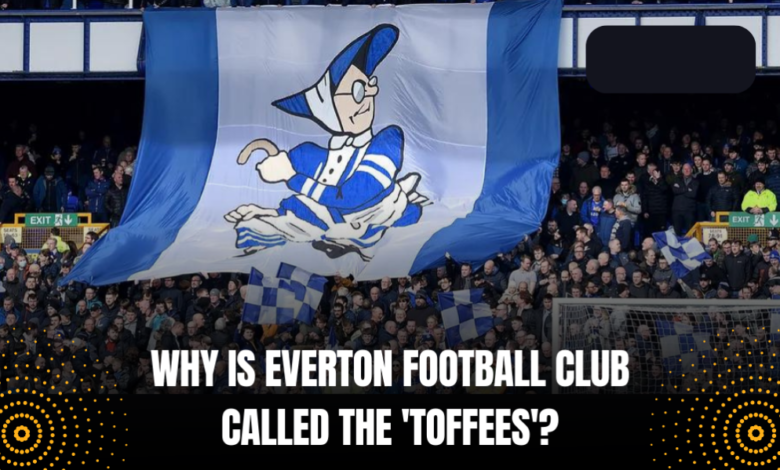
In the world of football, the deep-rooted connections between clubs and their fans often give rise to affectionate nicknames that resonate for generations. With a rich history dating back to 1878, Everton has nurtured a fiercely loyal fan base that spans generations. It is an institution with a rich and storied history, has long been known as “The Toffees.”
While multiple theories abound about the origins of Everton nickname, one particularly fascinating tale involves a charismatic and legendary candy vendor named Mother Noblett. In this article, we explore the captivating story of Mother Noblett and her influence on the culture of Everton FC, which ultimately led to the endearing name of “Toffees” for the club’s devoted fans.
Why is Everton FC nicknamed as Toffees?
To understand the origins of the Toffee nickname, we must travel back to the 1880s when Everton FC was flourishing as a prominent football club in Liverpool. Matches were played at Anfield, and football was quickly becoming a cherished pastime for the working-class people of the city. As the club began to solidify its place in the football landscape, a unique tradition was taking root outside the stadium, courtesy of Mother Noblett.
Mary Ellen Noblett, affectionately called Mother Noblett, was a warm and endearing figure who ran a small confectionery stall outside the Anfield stadium. Her stall was adorned with Everton’s blue and white colours, and she became famous for her delectable homemade toffees and other sweets. The incredible aroma of her treats made fans eagerly lined up before and after matches to indulge in her delicious creations.
Toffee – A Symbol For Everton
As Everton fans streamed into the stadium, they couldn’t resist a quick stop at Mother Noblett’s stall. The toffees quickly became synonymous with the club and the matchday experience. The act of purchasing and savouring her sweets became a cherished tradition for many Evertonians. In a time when football culture was rapidly evolving, Mother Noblett’s stall became a meeting point, where fans exchanged stories, shared laughs, and bonded over their passion for the club.
As Everton’s popularity surged, so did Mother Noblett’s reputation as the toffee vendor outside the stadium. The fans affectionately referred to her as “The Toffee Lady” and playfully started calling themselves the “Toffees,” a nod to the delicious treats they associated with Everton FC. The Everton nickname gained traction among the fans and began to feature in matchday chants and songs.
Beyond her role as the Toffee Lady, Mother Noblett’s genuine affection for the club and its supporters endeared her to the fans even more. She would often share her sweets with young supporters who couldn’t afford to buy them, earning her a place in the hearts of the community. Her humble and caring nature made her an unofficial matriarch of Everton’s fan base, and her contribution to the club’s culture remains unparalleled.
The Move To Goodison Park
As Everton outgrew Anfield, the club made a momentous decision to relocate to a new stadium, Goodison Park, in 1892. With the move, Mother Noblett’s iconic stall also made the transition, preserving the tradition of toffee sales on match days. This move further solidified the bond between the club, its fans, and the endearing Toffee Lady.
As Everton FC’s reputation spread, so did the Toffee nickname. It resonated not only among the fans but also within football circles and the broader community. The Everton nickname became a symbol of the club’s enduring connection to its supporters and its rich heritage. Though the passage of time took its toll, Mother Noblett’s legacy endured. Even after her passing, her stall continued to operate under the care of her family, ensuring that her cherished toffees remained a matchday staple for Everton fans.
While the story of Mother Noblett and the “Toffees” is widely embraced and celebrated, it is essential to acknowledge the complexity of the Everton nickname’s origin. Other theories, such as the association with Everton Mints or the Toffee-colored kit, continue to be part of the broader narrative. Each theory contributes to the rich tapestry of Everton’s history, demonstrating how folklore and tradition can intertwine to shape the identity of a football club.
Beyond the football pitch, the legacy of Mother Noblett serves as a reminder of the profound impact that individuals can have on the culture of a football club. The tale of Mother Noblett and the “Toffees” exemplifies the power of community, tradition, and passion in shaping the identity of a football club and its fans, highlighting the extraordinary journey of Everton FC throughout its illustrious history.
FAQ
Why is Everton FC nicknamed as Toffees?
Everton FC is nicknamed the Toffees because of the relationship with local toffee shops in the early days of the club. There are two stories about how the nickname came about.
Did Everton FC play at Anfield?
Yes, Everton FC played at Anfield from 1884 to 1892. It was their home ground until a dispute with the club president led them to move to Goodison Park. Everton won their first league championship at Anfield in 1891.
Who is Mother Noblett associated with Everton FC Nickname?
Mother Noblett was the owner of a toffee shop in Liverpool, England, that was located near Goodison Park, the home of Everton Football Club. She is credited with inventing the Everton Mint, a toffee with a white sugar shell that is striped black and white. The mints were popular with Everton fans, and they helped to solidify the club’s nickname “The Toffees.”




